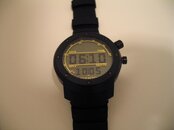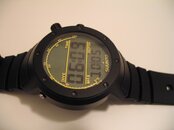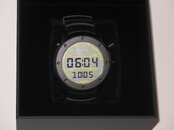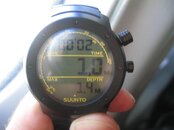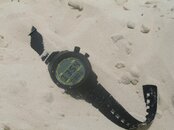jimzev
Registered
Aqua, water in Latin, is one of the archetypal classical elements and there is no word simpler and more succinct to name the new dive watch of Suunto. The Aqua is one of the three elements, or I should say devices, which comprise the new micro universe, or I should say the new watch line, the Elementum by Suunto.
So what is so special in this watch line that made the friends of the brand all over the world to count the days to pass, speculating on what was hiding behind the shadow? The curtain was finally drawn and I wan one of those that had the honor to receive one of the devices for review.
The Aqua arrived in a discrete back cube, with only one word written on: SUUNTO. The one I received has black case, black rubber band, and positive face. My initial reaction was at last, a black watch in my collection! and then thank God, it has a positive face. I was really concerned about the possibility of getting the negative face and though it would give a stealthy look to the watch, I think that the functionality of a dive watch is better served by a positive face. After all, I dont know any dive computer in the market with a negative face. The black case is stainless steel 316L, the standard marine grade stainless steel, and is very elegant. From some distance it might resemble an elegant black G-Shock; in fact a colleague of mine made exactly this comment; however a closer look reveals its uniqueness. The 41mm bezel has eight hex screws and its combination with the sapphire glass and the curved case reminds me of the viewing port of an atmospheric diving suit. Actually I think that this is the most beautiful feature of the watch, and though it resembles the bezel of a UTS model, the implementation by Suunto looks excellent.
Another unique feature of the watch is the huge crown pusher at two o clock, the one feature that is shared between all the Elementum devices. Being larger than the simple pusher at three o clock, it really stands out, adding an extra touch of different design culture. The crystal has yellow circular and linear markings which define the measurements taken under water. The two yellow lines help to inform about the current and maximum depth, and the dive time, while the circular marking is the analogue temperature scale (in centigrades and Fahrenait).
At eleven o clock, a silver button-like sensor is placed; personally I feel that due to its silver color, it doesnt fit to the rest of the design. The back of the case is fixed on the case with four Philips screws, while four holes at the twelve o clock position of the back side serve the depth sensor.
The black rubber band till now has withstood remarkably a lot of swimming and diving in saline environment, despite my initial concerns due to its softness. In fact, it is so soft and strong that makes me think of using it with my other dive watches.
So,, what about the functionality of the device? The device operates in two modes: TIME and DIVE mode. The TIME function is pretty simple, the hour and the minutes are placed at the middle of the screen, while at the bottom of the screen the date (month and day) are found. Dont ask about the reading of seconds, the main screen lacks it, despite the empty upper part of the screen which could provide the ideal space for this reading. The reason for this omission might be an attempt to avoid the refreshing of the screen every second and save some battery juice. The setup of the time requires pushing the crown for a few seconds. Then the time, date, and alarm setup is extremely easy by screwing the crown clockwise or anti-clockwise. Except for this two function (current time and alarm) the watch under the time mode doesnt have any other function, e.g. a timer.
Another interesting feature of the watch is a button lock function, which is activated by pushing the two pushers at the same time. Also, by pressing the middle pusher firmly in any mode, the backlight is activated.
The device switches automatically to DIVE mode when the silver sensor at 10 o clock contacts the water and reaches a depth more than 2ft. When the watch goes deeper than 4ft, it starts recording the depth and the dive time. The current depth appears at the middle of the screen, the maximum dive depth appears at the bottom, and the total dive time (in minutes and seconds) appears at the upper part of the screen. The device also reads the water temperature, which is defined by a black arc on the semi-ringed scale.
When surfacing, the watch starts showing the surface time. By pushing the middle pusher, the watch returns to the TIME mode, but if it is pushed again, the total surface time returns to the screen. I didnt manage to find out which is the maximum surface time that the watch can record, however it exceeds the 24 hours.
Another nice feature is the dive log function. The device logs the maximum depth and the dive time for the last 14 dives. The user has access to all the logged dives by turning the crown pusher. In this case, the start time and the date of the dive are presented on the screen, while at the upper part of the screen the dive log number is found. This number represents the number of the dive for a series of dives that occurred on the same date. The exact position of a dive in the log is defined by a black dot on the outer temperature scale (the older the dive is, the closer to the beginning of the temperature scale it will be). For each logged dive, a push of the crown pusher reveals the other two characteristics of the dive, the maximum depth and the duration of the dive. In order to return to the TIME mode, just push the middle pusher.
So how does the watch perform? Wearing the watch is very comfortable; it is light and sits quite comfortably on my big wrists. Though I was afraid that the crown pusher would tangle with clothes or equipment, it is so cleverly placed at 2 o clock that it is no hassle. The large digits are so distinctive that can be read with minimal effort. There are is no stopwatch function, which at least for me is one of the necessary features of a digital watch. On the other hand there is an alarm function and the volume of the alarm is the characteristic beep of all the Suunto watches. People sometimes complain that it is too low; however for a light sleeper like me this is not a problem.
The watch transforms once it contacts the water. The depth gauge readings are easy to read, and they must be accurate enough to compete with top-end dive computers. The deepest I reached with the device was 104ft, and the depth readings (max and current) were exactly the same with those of my Mares computer. Of course dont be mistaken; this is just a digital depth gauge, so it cannot replace a dive computer. However, for a recreational diver as me, this is quite enough as long as I keep in the recreational dive limits. The watch doesnt have functions as a fast ascend alarm, or 15ft safety stop timer, but a diver is trained not to rely on a dive computer to decide if (s)he ascends too fast, or have a safety stop. What really disappoints me is the thermometer; though it seems accurate enough, it is too hard to read the measurement in the inner scale. On top of this, the temperature reading is not logged, so usually when I have my rest stop, I have to focus on the screen, get the reading and memorize it in order to write it on my logbook.
The depth gauge is somewhat sensitive to the pressure change in a plane cabin during the landing, as the following photo exhibits. However this happened only twice during my last ten landings, so I assume that it is correlated with the specific pressure conditions of each flight.
The quality of the case, the crystal and the rubber band is very high; I wear the watch almost every day for the last two months, I have used it as a depth gauge for 18 times, banging it on cylinders, but no signs of wear are noticed. No scratch can be found on the case or the crystal and the band remains soft and strong.
The device has to compete with other well-designed watches that incorporate a depth gauge, as models of Citizen, Sector, and Tissot. At a retail price of US$899, according to a recent catalogue of a well-known American watch retailer, it might seem at the expensive side, but its unique look and the impressive quality of the construction justify the price.
Personally, I love the combination of a depth gauge with a watch that I can wear equally with business suits and casual clothes. The rubber band might not be appropriate for business attire; however replacing it with the black leather band of the Elementum line can really upgrade the watch. Especially if you travel for business, and you try to exploit any opportunity for a dive at your destination, then you can avoid carrying an extra dive watch and depth gauge; the Aqua can follow you from the meeting room to the deep blue.
Soon I will post some underwater photos with the device on action; unfortunately my digital camera flooded, so I had to use a classic 35mm waterproof one.
So what is so special in this watch line that made the friends of the brand all over the world to count the days to pass, speculating on what was hiding behind the shadow? The curtain was finally drawn and I wan one of those that had the honor to receive one of the devices for review.
The Aqua arrived in a discrete back cube, with only one word written on: SUUNTO. The one I received has black case, black rubber band, and positive face. My initial reaction was at last, a black watch in my collection! and then thank God, it has a positive face. I was really concerned about the possibility of getting the negative face and though it would give a stealthy look to the watch, I think that the functionality of a dive watch is better served by a positive face. After all, I dont know any dive computer in the market with a negative face. The black case is stainless steel 316L, the standard marine grade stainless steel, and is very elegant. From some distance it might resemble an elegant black G-Shock; in fact a colleague of mine made exactly this comment; however a closer look reveals its uniqueness. The 41mm bezel has eight hex screws and its combination with the sapphire glass and the curved case reminds me of the viewing port of an atmospheric diving suit. Actually I think that this is the most beautiful feature of the watch, and though it resembles the bezel of a UTS model, the implementation by Suunto looks excellent.
Another unique feature of the watch is the huge crown pusher at two o clock, the one feature that is shared between all the Elementum devices. Being larger than the simple pusher at three o clock, it really stands out, adding an extra touch of different design culture. The crystal has yellow circular and linear markings which define the measurements taken under water. The two yellow lines help to inform about the current and maximum depth, and the dive time, while the circular marking is the analogue temperature scale (in centigrades and Fahrenait).
At eleven o clock, a silver button-like sensor is placed; personally I feel that due to its silver color, it doesnt fit to the rest of the design. The back of the case is fixed on the case with four Philips screws, while four holes at the twelve o clock position of the back side serve the depth sensor.
The black rubber band till now has withstood remarkably a lot of swimming and diving in saline environment, despite my initial concerns due to its softness. In fact, it is so soft and strong that makes me think of using it with my other dive watches.
So,, what about the functionality of the device? The device operates in two modes: TIME and DIVE mode. The TIME function is pretty simple, the hour and the minutes are placed at the middle of the screen, while at the bottom of the screen the date (month and day) are found. Dont ask about the reading of seconds, the main screen lacks it, despite the empty upper part of the screen which could provide the ideal space for this reading. The reason for this omission might be an attempt to avoid the refreshing of the screen every second and save some battery juice. The setup of the time requires pushing the crown for a few seconds. Then the time, date, and alarm setup is extremely easy by screwing the crown clockwise or anti-clockwise. Except for this two function (current time and alarm) the watch under the time mode doesnt have any other function, e.g. a timer.
Another interesting feature of the watch is a button lock function, which is activated by pushing the two pushers at the same time. Also, by pressing the middle pusher firmly in any mode, the backlight is activated.
The device switches automatically to DIVE mode when the silver sensor at 10 o clock contacts the water and reaches a depth more than 2ft. When the watch goes deeper than 4ft, it starts recording the depth and the dive time. The current depth appears at the middle of the screen, the maximum dive depth appears at the bottom, and the total dive time (in minutes and seconds) appears at the upper part of the screen. The device also reads the water temperature, which is defined by a black arc on the semi-ringed scale.
When surfacing, the watch starts showing the surface time. By pushing the middle pusher, the watch returns to the TIME mode, but if it is pushed again, the total surface time returns to the screen. I didnt manage to find out which is the maximum surface time that the watch can record, however it exceeds the 24 hours.
Another nice feature is the dive log function. The device logs the maximum depth and the dive time for the last 14 dives. The user has access to all the logged dives by turning the crown pusher. In this case, the start time and the date of the dive are presented on the screen, while at the upper part of the screen the dive log number is found. This number represents the number of the dive for a series of dives that occurred on the same date. The exact position of a dive in the log is defined by a black dot on the outer temperature scale (the older the dive is, the closer to the beginning of the temperature scale it will be). For each logged dive, a push of the crown pusher reveals the other two characteristics of the dive, the maximum depth and the duration of the dive. In order to return to the TIME mode, just push the middle pusher.
So how does the watch perform? Wearing the watch is very comfortable; it is light and sits quite comfortably on my big wrists. Though I was afraid that the crown pusher would tangle with clothes or equipment, it is so cleverly placed at 2 o clock that it is no hassle. The large digits are so distinctive that can be read with minimal effort. There are is no stopwatch function, which at least for me is one of the necessary features of a digital watch. On the other hand there is an alarm function and the volume of the alarm is the characteristic beep of all the Suunto watches. People sometimes complain that it is too low; however for a light sleeper like me this is not a problem.
The watch transforms once it contacts the water. The depth gauge readings are easy to read, and they must be accurate enough to compete with top-end dive computers. The deepest I reached with the device was 104ft, and the depth readings (max and current) were exactly the same with those of my Mares computer. Of course dont be mistaken; this is just a digital depth gauge, so it cannot replace a dive computer. However, for a recreational diver as me, this is quite enough as long as I keep in the recreational dive limits. The watch doesnt have functions as a fast ascend alarm, or 15ft safety stop timer, but a diver is trained not to rely on a dive computer to decide if (s)he ascends too fast, or have a safety stop. What really disappoints me is the thermometer; though it seems accurate enough, it is too hard to read the measurement in the inner scale. On top of this, the temperature reading is not logged, so usually when I have my rest stop, I have to focus on the screen, get the reading and memorize it in order to write it on my logbook.
The depth gauge is somewhat sensitive to the pressure change in a plane cabin during the landing, as the following photo exhibits. However this happened only twice during my last ten landings, so I assume that it is correlated with the specific pressure conditions of each flight.
The quality of the case, the crystal and the rubber band is very high; I wear the watch almost every day for the last two months, I have used it as a depth gauge for 18 times, banging it on cylinders, but no signs of wear are noticed. No scratch can be found on the case or the crystal and the band remains soft and strong.
The device has to compete with other well-designed watches that incorporate a depth gauge, as models of Citizen, Sector, and Tissot. At a retail price of US$899, according to a recent catalogue of a well-known American watch retailer, it might seem at the expensive side, but its unique look and the impressive quality of the construction justify the price.
Personally, I love the combination of a depth gauge with a watch that I can wear equally with business suits and casual clothes. The rubber band might not be appropriate for business attire; however replacing it with the black leather band of the Elementum line can really upgrade the watch. Especially if you travel for business, and you try to exploit any opportunity for a dive at your destination, then you can avoid carrying an extra dive watch and depth gauge; the Aqua can follow you from the meeting room to the deep blue.
Soon I will post some underwater photos with the device on action; unfortunately my digital camera flooded, so I had to use a classic 35mm waterproof one.




